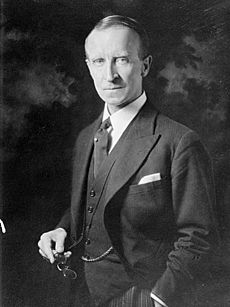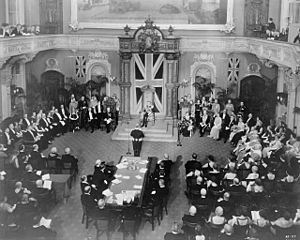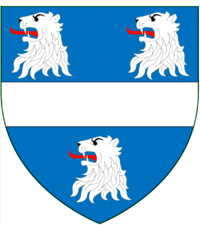John Buchan facts for kids
Quick facts for kids
The Lord Tweedsmuir
|
|
|---|---|

Buchan in 1935
|
|
| 15th Governor General of Canada | |
| In office 2 November 1935 – 11 February 1940 |
|
| Monarch | |
| Prime Minister | William Lyon Mackenzie King |
| Preceded by | The Earl of Bessborough |
| Succeeded by | The Earl of Athlone |
| Personal details | |
| Born |
John Buchan
26 August 1875 Perth, Scotland |
| Died | 11 February 1940 (aged 64) Montreal, Quebec, Canada |
| Political party | Scottish Unionist |
| Spouse |
Susan Grosvenor
(m. 1907) |
| Children | 4, including John, William and Alastair |
| Relatives | O. Douglas (sister) |
| Alma mater | |
| Profession | Author |
| Signature |  |
John Buchan, 1st Baron Tweedsmuir (born 26 August 1875 – died 11 February 1940) was a Scottish writer and politician. He is best known for his adventure novels, especially The Thirty-Nine Steps.
He also served as the Governor General of Canada, which is the King's representative in Canada. He was the 15th person to hold this important role since Canada became a country.
Contents
Early Life and Education
John Buchan was born in Perth, Scotland, on 26 August 1875. He was the first child of John Buchan, a church minister, and Helen Jane Buchan. He grew up in Kirkcaldy, Scotland.
He spent many summer holidays in Broughton. There, he learned to love walking and exploring nature. These experiences often appeared in his books later on.
Buchan was a very bright student. At 17, he won a scholarship to the University of Glasgow. He studied old languages and history. He also started writing poetry and had some of his work published.
Later, he went to Brasenose College, Oxford, to continue his studies. While at Oxford, he won several writing awards. He was also chosen to be the president of the Oxford Union, a famous debating society. By the time he graduated, he had already published six books.
Life as a Writer and Politician
After university, John Buchan worked in government and diplomacy. In 1901, he became a private secretary in southern Africa. This experience gave him ideas for his future books.
When he returned to London, he started working for a publishing company. He also became an editor for The Spectator magazine.
On 15 July 1907, he married Susan Charlotte Grosvenor. They had four children together. Two of their children later lived most of their lives in Canada.
In 1910, Buchan wrote Prester John, his first adventure novel. It was set in South Africa. He also started to get involved in politics.
When the First World War began, Buchan wrote for the British government. His job was to create propaganda to support the war effort. In 1915, he published his most famous book, The Thirty-Nine Steps. It was a spy thriller set before the war. The main character, Richard Hannay, became very popular.
After the war, Buchan focused on writing historical books and more thrillers. In 1927, he was elected to the British Parliament. He represented the Scottish universities. He believed in promoting Scotland as a nation within the British Empire.
In 1932, King George V honored Buchan for his contributions to literature. He was given the Order of the Companions of Honour.
In 1935, his book The Thirty-Nine Steps was made into a movie by Alfred Hitchcock. This happened in the same year that Buchan was given another honor. He was made a Baron by King George V. This meant he became Lord Tweedsmuir. This was done because he was about to become the Governor General of Canada.
Serving Canada as Governor General
On 2 November 1935, Lord Tweedsmuir officially became the Governor General of Canada. The ceremony took place in Quebec City. He was the first Governor General appointed after Canada gained more independence in 1931. This meant the King of Canada chose him with advice from Canadian leaders.
Lord Tweedsmuir already knew a lot about Canada. He had written about the country and visited it before. He loved Canada's history and wanted more people to learn about it.
He continued to write books while he was Governor General. He also took his role very seriously. He wanted to travel all across Canada, even to the Arctic. His goal was to help unite Canadians. He said that a Governor General's job is to know "the whole of Canada and all the various types of her people."
Lord Tweedsmuir also encouraged Canadians to have their own strong identity. He believed that different groups of people in Canada should keep their unique cultures. He thought this would make Canada stronger.
In 1936, King George V died, and his son Edward became King Edward VIII. However, King Edward decided to give up the throne later that year. His younger brother, Albert, became King George VI. Lord Tweedsmuir helped Canada follow these changes in the monarchy.
In 1939, King George VI and Queen Elizabeth visited Canada. Lord Tweedsmuir had suggested this royal tour. He wanted Canadians to see their King in person. This showed that Canada was an independent kingdom. The royal visit was a huge success and helped bring Canadians together.
Lord Tweedsmuir also worked to prevent another world war. He worked with Canada's Prime Minister, William Lyon Mackenzie King, and U.S. President Franklin D. Roosevelt. However, when the Second World War began in September 1939, he authorized Canada's declaration of war against Germany. As the King's representative, he was the commander-in-chief of Canada's armed forces.
Later Life and Legacy
On 6 February 1940, Lord Tweedsmuir suffered a serious head injury. He died on 11 February 1940. Prime Minister Mackenzie King gave a radio speech, saying that Canada had lost "one of the greatest and most revered of their Governors General."
After a state funeral in Ottawa, his ashes were returned to the United Kingdom. He was buried in Elsfield, England, the village where he lived.
In his last years, Lord Tweedsmuir wrote his autobiography, Memory Hold-the-Door. He also wrote books about Canadian history. He and his wife created the first proper library at Rideau Hall, the Governor General's residence.
He also started the Governor General's Literary Awards. These awards are still Canada's most important awards for literature today.
Lord Tweedsmuir wrote nearly 30 novels and many other works. His spy thrillers are still his most famous books.
Tweedsmuir Provincial Park in British Columbia is named after him. It was created in 1938 after he visited the area. He wrote that he had "seen nothing more beautiful and more wonderful than the great park which British Columbia has done me the honour to call by my name."
Honours and Awards
Lord Tweedsmuir received many honours during his life. These included:
- Order of the Companions of Honour (CH)
- Knight Grand Cross of the Most Distinguished Order of Saint Michael and Saint George (GCMG)
- Knight Grand Cross of the Royal Victorian Order (GCVO)
- Member of His Majesty's Most Honourable Privy Council (PC)
He also received several medals and honorary degrees from universities.
Places and Schools Named After Him
Many places and schools in Canada and Scotland are named after John Buchan or Lord Tweedsmuir:
- Tweedsmuir South Provincial Park and Tweedsmuir North Provincial Park and Protected Area in British Columbia.
- Tweedsmuir Peak in British Columbia.
- Several avenues and roads in Canadian cities like Ottawa, Toronto, and Winnipeg.
- Buchan Street in Montreal.
- Strathcona-Tweedsmuir School in Alberta.
- Lord Tweedsmuir Elementary School and Lord Tweedsmuir Secondary School in British Columbia.
- John Buchan Senior Public School in Toronto.
- The John Buchan Centre in Broughton, Scotland.
| Viceregal styles of the Lord Tweedsmuir (1935–1940) |
|
|---|---|
 |
|
| Reference style | His Excellency the Right Honourable Son Excellence le très honorable |
| Spoken style | Your Excellency Votre Excellence |
| Ribbon bars of the Lord Tweedsmuir (incomplete) | |||
|---|---|---|---|
Images for kids
-
Medals of John Buchan in the National Museum of Scotland
|
See also
 In Spanish: John Buchan para niños
In Spanish: John Buchan para niños
- List of works by John Buchan
- List of Scottish novelists








